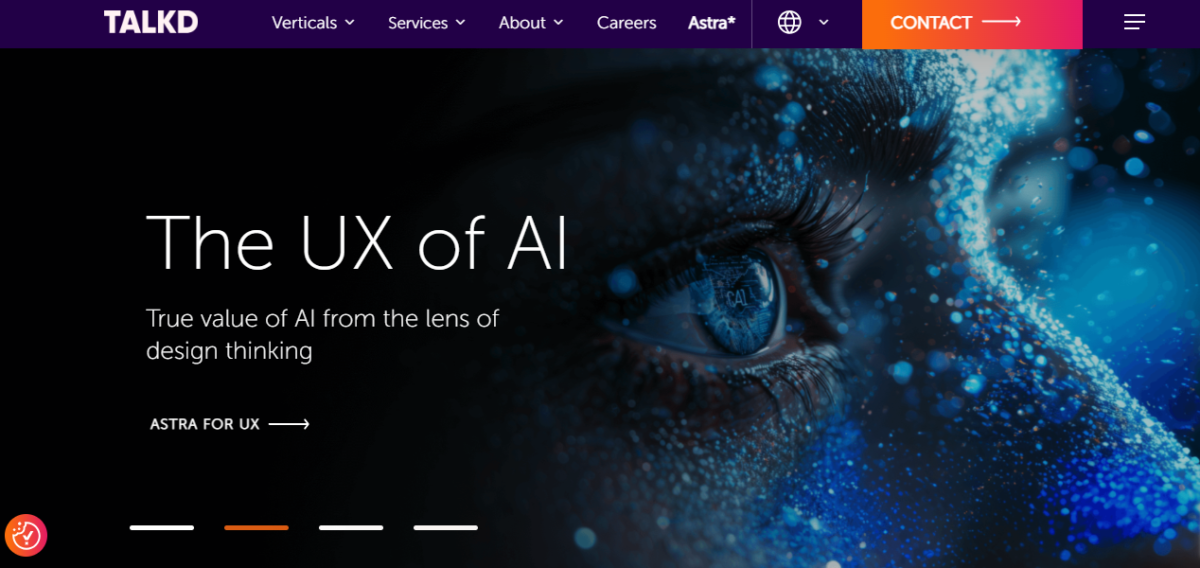Human-Centered AI: Crafting Intuitive User Experiences

As AI and machine learning (ML) become integral parts of our daily lives. The focus on creating intuitive and human-centered technology has never been more important.
A well-designed user experience in AI ensures that the technology feels seamless, accessible, and humane, aligning with the intentions and needs of end-users. To achieve this, integrating design thinking into AI solutioning is essential, as it places the user at the core of every development phase.
Want to learn more? Click here
At the forefront of AI innovation, we are harnessing the power of design thinking to create human-centered AI solutions that are practical, intuitive, and future-proof. Here’s how we do it:
1. User-Centric Research: Discovering the “Whys” and “Hows”
The foundation of any successful AI solution lies in understanding the end-user. Through rigorous user-centric research, we dig deep to uncover the “whys” and “hows” that define audience behavior, preferences, and pain points.
These insights become the cornerstone of AI solutions that not only meet but exceed user expectations. Rather than assumptions, we rely on data-driven insights to ensure that AI technologies address real-world needs.
2. Design Thinking Sessions: Right-Sizing AI for Real-World Solutions
Certified design thinkers are at the heart of our process, constantly exploring AI workflows with the user as the pivot. In these sessions, we ensure that AI models are right-sized, meaning they are tailored to meet specific needs without overcomplicating the user experience.
This makes the AI solution more practical and aligned with real-world applications, enhancing both its functionality and usability.
3. Holistic User Journey Mapping: Addressing Bottlenecks with ML
Instead of focusing solely on isolated touchpoints, we take a holistic approach to visualize the entire user journey. By doing so, we can identify potential bottlenecks and inefficiencies that machine learning (ML) models can address.
Whether it’s optimizing a step in the process or improving decision-making, our journey mapping ensures that AI serves the user efficiently and smoothly.
4. Architecting AI Workflows: Building for the End User
Architecting AI workflows is a critical step in delivering exceptional user experiences. We employ proven methodologies to design workflows that guide engineers in building AI experiences that cater to all possible user needs.
These workflows are comprehensive, considering every possible interaction point and scenario, ensuring that the AI technology is well-rounded and responsive.
Deep User Research: No Assumptions, Only Understanding
Deep user research goes beyond surface-level data. We meticulously study the nuances of how users interact with AI technologies. By identifying their frustrations, desires, and expectations, we craft solutions that truly resonate.
This research informs every stage of development, leading to AI that feels intuitive and helpful, rather than complex or alienating.
Design Thinking Expertise: Creating Human-AI Synergy
Our expertise in design thinking allows us to approach AI with a human-centered lens. Understanding the dynamics of human-ML interactions helps us create solutions that are both functional and emotionally intelligent.
We focus on making AI feel like a natural extension of the user’s capabilities, enhancing their experience rather than complicating it.
Human-Centered Approach: Prioritizing User Needs
At the core of our AI development process is a human-centered approach. We prioritize the user’s needs, ensuring that the technology supports and augments their tasks.
By keeping the user at the forefront, we help businesses unlock the full potential of AI while delivering a more personalized and empathetic experience.
Rapid Validation: Usability Testing for Quick Iteration
Our rapid validation process involves frequent usability testing to identify issues early and resolve them quickly. This ensures that AI solutions evolve in real-time based on user feedback, making continuous improvements to workflows and ensuring that usability issues are addressed before they become larger problems.
Conclusion: Elevating AI with Human-Centered Design
In a world where AI is shaping the future, the need for human-centered solutions is more pressing than ever. By integrating design thinking and user-centric research into AI workflows, we create technology that serves, understands, and enhances the user experience.
Our approach ensures that AI remains intuitive, accessible, and deeply aligned with human needs, transforming challenges into opportunities for innovation.
For businesses looking to adopt AI, the focus must remain on creating solutions that are not only powerful but also deeply intuitive and user-friendly.
The future of AI lies in its ability to enhance human potential, and with the right approach, we can make that future a reality. For reading interesting articles like this click here.





